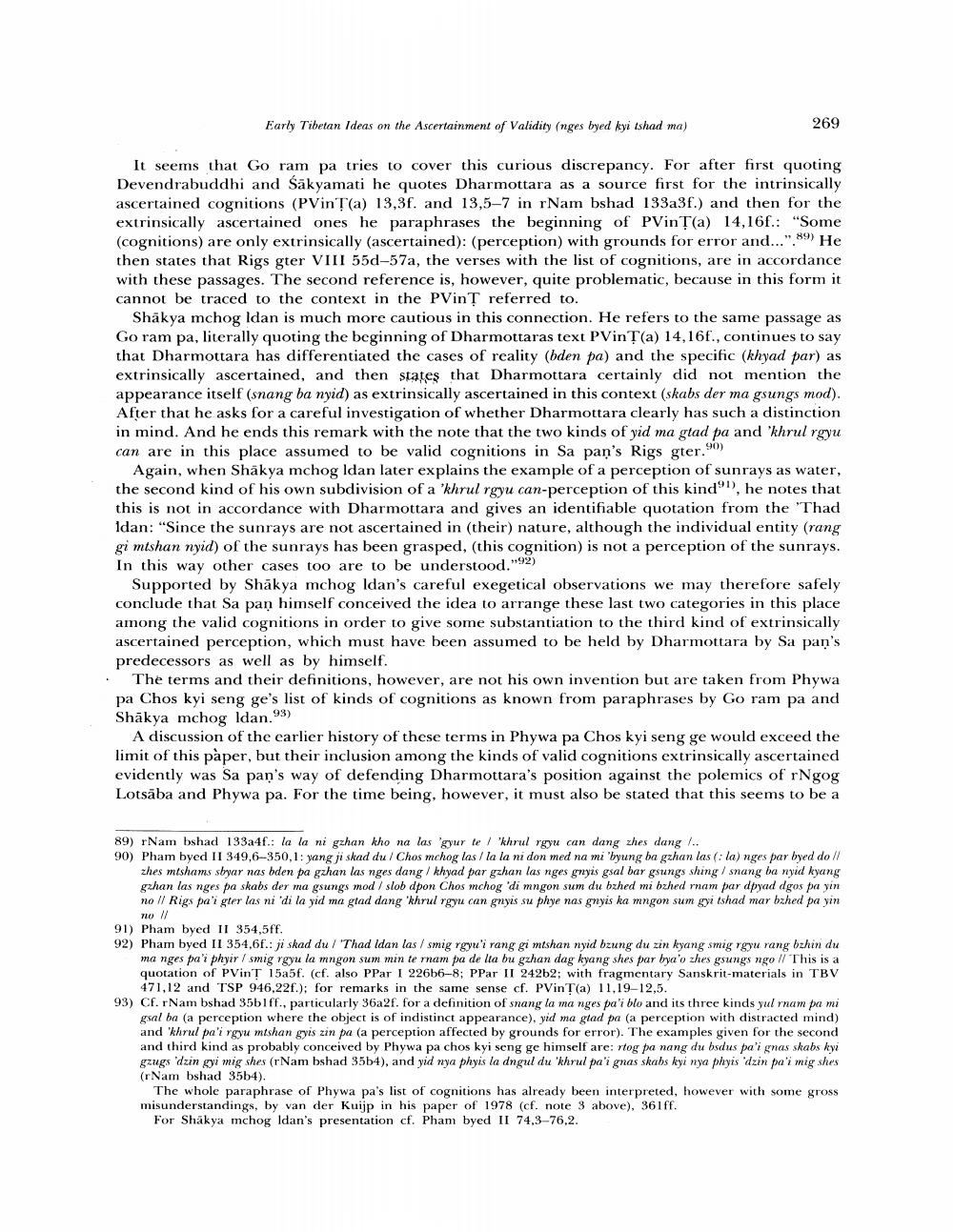________________
269
Early Tibetan Ideas on the Ascertainment of Validity (nges byed kyi tshad ma)
It seems that Go ram pa tries to cover this curious discrepancy. For after first quoting Devendrabuddhi and Śākyamati he quotes Dharmottara as a source first for the intrinsically ascertained cognitions (PVinŢ(a) 13,3f. and 13,5-7 in rNam bshad 133a3f.) and then for the extrinsically ascertained ones he paraphrases the beginning of PVinȚ(a) 14,16f.: "Some (cognitions) are only extrinsically (ascertained): (perception) with grounds for error and...".89) He then states that Rigs gter VIII 55d-57a, the verses with the list of cognitions, are in accordance with these passages. The second reference is, however, quite problematic, because in this form it cannot be traced to the context in the PVinȚ referred to.
Shakya mchog Idan is much more cautious in this connection. He refers to the same passage as Go ram pa, literally quoting the beginning of Dharmottaras text PVinȚ(a) 14,16f., continues to say that Dharmottara has differentiated the cases of reality (bden pa) and the specific (khyad par) as extrinsically ascertained, and then states that Dharmottara certainly did not mention the appearance itself (snang ba nyid) as extrinsically ascertained in this context (skabs der ma gsungs mod). After that he asks for a careful investigation of whether Dharmottara clearly has such a distinction in mind. And he ends this remark with the note that the two kinds of yid ma gtad pa and 'khrul rgyu can are in this place assumed to be valid cognitions in Sa pan's Rigs gter.90)
Again, when Shakya mchog Idan later explains the example of a perception of sunrays as water, the second kind of his own subdivision of a 'khrul rgyu can-perception of this kind, he notes that this is not in accordance with Dharmottara and gives an identifiable quotation from the 'Thad Idan: "Since the sunrays are not ascertained in (their) nature, although the individual entity (rang gi mtshan nyid) of the sunrays has been grasped, (this cognition) is not a perception of the sunrays. In this way other cases too are to be understood."92)
Supported by Shakya mchog Idan's careful exegetical observations we may therefore safely conclude that Sa pan himself conceived the idea to arrange these last two categories in this place among the valid cognitions in order to give some substantiation to the third kind of extrinsically ascertained perception, which must have been assumed to be held by Dharmottara by Sa pan's predecessors as well as by himself.
The terms and their definitions, however, are not his own invention but are taken from Phywa pa Chos kyi seng ge's list of kinds of cognitions as known from paraphrases by Go ram pa and Shakya mchog Idan.93)
A discussion of the earlier history of these terms in Phywa pa Chos kyi seng ge would exceed the limit of this paper, but their inclusion among the kinds of valid cognitions extrinsically ascertained evidently was Sa pan's way of defending Dharmottara's position against the polemics of rNgog Lotsaba and Phywa pa. For the time being, however, it must also be stated that this seems to be a
89) rNam bshad 133a4f.: la la ni gzhan kho na las gyur te 'khrul rgyu can dang zhes dang !..
90) Pham byed II 349,6-350,1: yang ji skad du / Chos mchog las / la la ni don med na mi 'byung ba gzhan las (: la) nges par byed do // zhes mtshams sbyar nas bden pa gzhan las nges dang/ khyad par gzhan las nges gnyis gsal bar gsungs shing/ snang ba nyid kyang gzhan las nges pa skabs der ma gsungs mod / slob dpon Chos mchog 'di mngon sum du bzhed mi bzhed rnam par dpyad dgos pa yin no II Rigs pa'i gter las ni 'di la yid ma gtad dang 'khrul rgyu can gnyis su phye nas gnyis ka mngon sum gyi tshad mar bzhed payin no ll
91) Pham byed II 354,5ff.
92) Pham byed II 354,6f.: ji skad du / Thad Idan las / smig rgyu'i rang gi mtshan nyid bzung du zin kyang smig rgyu rang bzhin du ma nges pa'i phyir / smig rgyu la mngon sum min te rnam pa de lta bu gzhan dag kyang shes par bya'o zhes gsungs ngo // This is a quotation of PVinȚ 15a5f. (cf. also PPar I 226b6-8; PPar II 242b2; with fragmentary Sanskrit-materials in TBV 471,12 and TSP 946,22f.); for remarks in the same sense cf. PVinȚ(a) 11,19-12,5.
93) Cf. rNam bshad 35b1ff., particularly 36a2f. for a definition of snang la ma nges pa'i blo and its three kinds yul rnam pa mi gsal ba (a perception where the object is of indistinct appearance), yid ma gtad pa (a perception with distracted mind) and 'khrul pa'i rgyu mtshan gyis zin pa (a perception affected by grounds for error). The examples given for the second and third kind as probably conceived by Phywa pa chos kyi seng ge himself are: rtog pa nang du bsdus pa'i gnas skabs kyi gzugs 'dzin gyi mig shes (rNam bshad 35b4), and yid nya phyis la dngul du 'khrul pa'i gnas skabs kyi nya phyis 'dzin pa'i mig shes (rNam bshad 35b4).
The whole paraphrase of Phywa pa's list of cognitions has already been interpreted, however with some gross misunderstandings, by van der Kuijp in his paper of 1978 (cf. note 3 above), 361ff.
For Shakya mchog Idan's presentation cf. Pham byed II 74,3-76,2.




